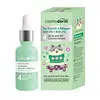What's inside
What's inside
 Key Ingredients
Key Ingredients

 Benefits
Benefits

 Concerns
Concerns

 Ingredients Side-by-side
Ingredients Side-by-side

Water
Skin ConditioningNiacinamide
SmoothingButylene Glycol
HumectantHydroxyethyl Urea
HumectantPyridoxine Cyclic Phosphate
Skin ConditioningBetaine
HumectantMethyl Gluceth-20
HumectantEthoxydiglycol
HumectantSuccinic Acid
BufferingPhenoxyethanol
PreservativeSalicylic Acid
MaskingBiosaccharide Gum-1
HumectantPEG-20
HumectantGlycerin
HumectantCaprylic/Capric Triglyceride
MaskingAllantoin
Skin ConditioningDehydroxanthan Gum
Emulsion StabilisingEthylhexylglycerin
Skin ConditioningLecithin
EmollientDisodium EDTA
Tocopheryl Acetate
AntioxidantSodium Hyaluronate
HumectantHarungana Madagascariensis Extract
Skin ConditioningAscorbic Acid
AntioxidantWater, Niacinamide, Butylene Glycol, Hydroxyethyl Urea, Pyridoxine Cyclic Phosphate, Betaine, Methyl Gluceth-20, Ethoxydiglycol, Succinic Acid, Phenoxyethanol, Salicylic Acid, Biosaccharide Gum-1, PEG-20, Glycerin, Caprylic/Capric Triglyceride, Allantoin, Dehydroxanthan Gum, Ethylhexylglycerin, Lecithin, Disodium EDTA, Tocopheryl Acetate, Sodium Hyaluronate, Harungana Madagascariensis Extract, Ascorbic Acid
 Reviews
Reviews

Ingredients Explained
These ingredients are found in both products.
Ingredients higher up in an ingredient list are typically present in a larger amount.
Biosaccharide Gum-1 is a sugar created by fermenting sorbitol (which usually comes from potato starch!). It is known for its soothing and moisturizing properties.
Manufacturer tests show this ingredient helped reduce irritation from lactic acid by almost half and kept skin hydrated long-term as a humectant
Beyond hydration, Biosaccharide Gum-1 gives formulas a silky, non-sticky feel.
This ingredient is gentle, versatile, and suitable for all skin types.
Fun fact: Similar sugars can be found naturally in fruits like apples and pears.
Learn more about Biosaccharide Gum-1Ethoxydiglycol is a synthetic solvent.
Solvents are used to keep ingredients together in a product. They can help dissolve ingredients to stable bases or help evenly distribute ingredients throughout the product.
Ethoxydiglycol also helps deliver other key ingredients into the skin.
Learn more about EthoxydiglycolSalicylic Acid (also known as beta hydroxy acid or BHA) is a well-known ingredient for treating skin that struggles with acne and clogged pores. It exfoliates both the skin's surface and deep within the pores to help clear out buildup, control oil, and reduce inflammation.
Unlike AHAs (alpha hydroxy acids), salicylic acid is oil-soluble. This allows it to penetrate into pores which makes it especially effective for treating blackheads and preventing future breakouts.
Salicylic acid is also known for its soothing properties. It has a similar structure to aspirin and can calm inflamed or irritated skin, making it a good option for acne-prone skin that is also sensitive.
Concentrations of 0.5-2% are recognized by the U.S. FDA as an over-the-counter topical acne product.
It can cause irritation and/or dryness if one's skin already has a compromised moisture barrier, so it's best to focus on repairing that before introducing this ingredient into your routine.
While salicylic acid does not increase sun sensitivity, it’s still important to wear sunscreen daily to protect your skin.
If you are looking for the ingredient called BHA or Butylated Hydroxyanisole, click here.
Learn more about Salicylic AcidWater. It's the most common cosmetic ingredient of all. You'll usually see it at the top of ingredient lists, meaning that it makes up the largest part of the product.
So why is it so popular? Water most often acts as a solvent - this means that it helps dissolve other ingredients into the formulation.
You'll also recognize water as that liquid we all need to stay alive. If you see this, drink a glass of water. Stay hydrated!
Learn more about Water